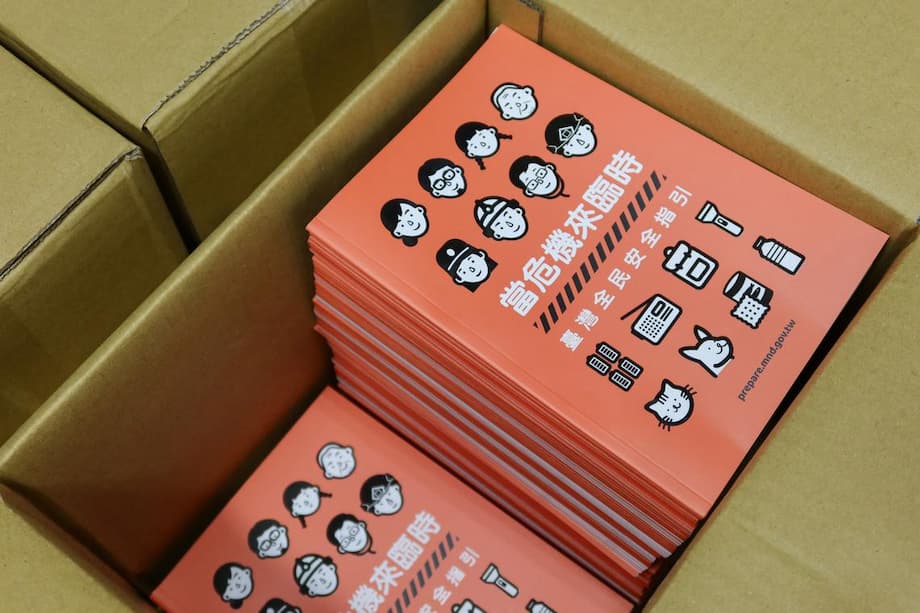New guidance for civilians under pressure from China
Taiwan will issue an updated civil defence handbook next week that adds clear instructions for civilians who encounter enemy soldiers and spells out a central rule for information discipline in wartime. Any claim that the government has surrendered should be treated as false. The bright red orange, 29 page guide is part of a broad push to strengthen public readiness for emergencies, from earthquakes and typhoons to a potential conflict with China.
- New guidance for civilians under pressure from China
- What the 29 page guide tells people to do
- Why prepare now, and what lessons shape the plan
- Countering misinformation and deepfakes
- Digital risk from popular tech and apps
- Building resilience beyond the battlefield
- Civil society training takes off
- Practical steps for households
- Regional and international stakes
- What to Know
Beijing claims Taiwan as its territory and has not renounced the use of force. Taiwan’s elected leaders reject that claim and say only the island’s people can decide their future. Military exercises, coast guard patrols, and increasingly complex maneuvers around the island have become more frequent, which raises the value of simple, widely accessible civil defence directions.
The handbook’s design aims to reach readers of all ages. It explains how to locate bomb shelters using smartphone apps and how to assemble a basic kit for each family member, including pets. It urges communities to look out for one another and to safeguard the island’s shared home, an appeal that runs through the text.
This edition builds on a first version released in 2022. Editors expanded sections on wartime contingencies, ranging from sabotage of undersea communications cables and cyber attacks, to inspections of Taiwanese vessels by a hostile power that could precede a blockade, and a full scale invasion.
A prominent change centers on information integrity. The guide warns that hostile actors will attempt to use false narratives to divide society, often by spreading deepfake videos and rumors amplified by local collaborators. It states clearly that claims of surrender or defeat during an invasion should be considered false.
What the 29 page guide tells people to do
If civilians detect an enemy presence, the instruction is to leave the area promptly if it is safe to do so, or take cover in a secure place away from windows. The handbook urges people to avoid taking or uploading photos and videos that could reveal troop locations, checkpoints, or police movements. In a crisis, normal habits on social media can put lives at risk and can aid an adversary.
The guide lists practical steps families can prepare in peacetime. It points to smartphone tools that map public shelters, and it explains what to pack in emergency kits, from essential medications and water to chargers, copies of identification, and contact lists. The section on children encourages parents to speak calmly and clearly, to practice simple routines, and to give kids age appropriate tasks that build confidence.
Officials frame these instructions as part of a defensive plan that relies on civilian restraint with sensitive imagery and movements that could be exploited by an enemy.
Mr Shen Wei chih, a director at the Taiwan military’s All out Defence Mobilisation Agency, said operational security depends on ordinary citizens keeping cameras down during a crisis.
Mr Shen said: “That could compromise military movements, which is detrimental to our defensive operations.”
The handbook also cautions that false orders and fake announcements may circulate online. Residents are urged to rely on verified government alerts and trusted broadcasters for instructions, and to treat unexpected messages about surrender or ceasefire as suspect until confirmed by official channels.
Why prepare now, and what lessons shape the plan
Taiwan’s leaders see civil readiness as part of deterrence. Russia’s invasion of Ukraine showed how quickly critical services and communications can be targeted, and how community training, first aid skills, and clear public guidance can prevent chaos. Taipei also argues that authoritarian expansion is a global challenge that affects the Indo Pacific directly.
Lin Fei fan, deputy secretary general of the National Security Council, oversaw the update. He said Taiwan studied guides prepared by fellow democracies, including the Czech Republic and France, to find approaches that fit local needs and culture.
Mr Lin said: “The global situation, whether in Europe or the Indo Pacific region, is not a distant concern. It is right at our doorstep.”
Lin emphasized that the goal is empowerment, not alarm. The handbook aims to give families practical ways to reduce risk and to keep society functioning even under stress.
Mr Lin said: “The goal is not to make everyone feel afraid. Rather, the information is intended to help people develop better coping strategies when a real crisis occurs.”
Civil preparedness has progressed alongside military exercises. This year Taiwan staged the longest Han Kuang drills to date, testing defense of ports and airports, responses to coastal landings, and coordination across emergency services. Authorities highlighted new deliveries of equipment, maritime drones for surveillance, and refinements to logistics and medical evacuation.
Countering misinformation and deepfakes
The updated handbook devotes significant space to information warfare. It warns that foreign actors and their proxies are likely to flood social networks with false narratives, doctored audio, and fabricated clips designed to confuse, alarm, or sap morale. These tactics can create panic, disrupt logistics, and distract emergency responders.
Deepfakes use artificial intelligence to alter video or audio so that a person appears to say or do something that never happened. In a fast moving crisis, a well crafted deepfake can spread faster than corrections. The guide advises citizens to check the source, compare with multiple official outlets, look for inconsistencies in lighting and lip sync, and to treat sensational claims, especially about surrender or ceasefire, with caution until confirmed by authorities.
Taiwan has invested in digital literacy programs, and civic groups teach basic verification skills. The new guidance strengthens the link between personal behavior online and national security, underscoring that careless sharing of unverified clips can aid an adversary.
Digital risk from popular tech and apps
The new edition also flags potential security risks tied to China made hardware and software. It points to popular platforms such as WeChat and TikTok, as well as an artificial intelligence service known as DeepSeek AI, along with networked cameras and other smart devices. The concern is that these tools could be exploited in a crisis to track users, collect sensitive data, or push targeted disinformation.
Authorities advise caution with connected devices during emergencies. People may be asked to curb permissions, log out of nonessential apps, or power down certain equipment if instructed by official alerts. The aim is to reduce digital footprints that hostile operators might use to map movements or to disrupt critical communications.
Building resilience beyond the battlefield
The handbook is one part of a wider whole of society resilience campaign championed by President Lai Ching te. The plan blends civilian training, strategic stockpiles, infrastructure protection, and secure communications so that essential services continue even if shocks occur.
Government planners describe five pillars that support continuity during disasters and conflict:
- Civilian training for emergency response, supply distribution, and support for victims, with a goal to train hundreds of thousands of volunteers across neighborhoods and workplaces.
- Strategic stockpiles of food, fuel, and medical supplies, plus the logistics to move them quickly to where they are needed.
- Protection of critical infrastructure, especially power and water, supported by reserves and grid security upgrades.
- Social welfare, evacuation, and medical staging through local relief and evacuation centers that can scale rapidly.
- Secure information and communications systems, including redundant networks, satellite links, and cloud backups to keep alerts and public services running.
Ministries, city governments, and private partners are building local coordination hubs and apps that track supplies and shelter capacity. The Ministry of Digital Affairs is expanding redundant communications so alerts can function if cables are cut or cell towers are damaged. Taiwan maintains a large network of public air raid shelters, and many schools and community buildings are designated for relief and evacuation in an emergency.
Regular exercises test these plans and reveal gaps for follow up. Officials acknowledge that coordination across agencies can be challenging, yet practicing together reduces confusion when seconds matter and helps volunteers and professionals work from the same playbook.
Civil society training takes off
Grassroots groups complement official programs. Organizations such as Forward Alliance and Kuma Academy run workshops on trauma care, evacuation planning, media literacy, and basic cybersecurity. Interest rose after the war in Ukraine, and courses often fill quickly as residents look for practical ways to help their communities during a crisis.
These groups work alongside local firefighters, medics, and reserve units to build skills that are useful in both disasters and conflict. Volunteers learn how to control bleeding, organize supplies at a shelter, verify information before sharing it, and support vulnerable neighbors. The guiding idea is simple, prepared communities are safer communities.
Practical steps for households
The updated guide distills everyday actions that reduce risk and give families confidence if an emergency unfolds. The following checklist reflects its core advice for civilians.
- Locate the nearest public shelter using official map apps and save a paper map in case networks fail.
- Assemble a go bag for each family member with water, snacks, essential medications, copies of identification, cash, a flashlight, a portable charger, and a small radio.
- Include supplies for pets, such as food, water, a carrier, vaccination records, and comfort items.
- Set a family plan with two meeting points, one near home and one farther away, and a method to check in if phone networks are disrupted.
- Learn basic first aid and bleeding control, and keep a small kit at home and at work.
- Avoid filming troop movements, checkpoints, or emergency responders. Do not share locations or routes online.
- Stick to official alerts from government channels, and treat unexpected messages about surrender or ceasefire as false unless confirmed by authorities.
- Speak with children in age appropriate language, practice simple safety routines, and maintain familiar comforts to reduce stress.
- Be cautious with connected devices and apps. Limit permissions or power down nonessential devices if instructed by official alerts.
- Report suspicious activity through local hotlines or police, without taking personal risks.
Regional and international stakes
Taipei warns of a spectrum of possible stress tests. These range from sabotage of undersea cables and cyber attacks that disrupt hospitals or power, to inspections of Taiwanese vessels by a foreign force that could escalate into a blockade, and finally a direct assault. Clear civilian guidance is designed to keep society steady regardless of where along that spectrum a crisis begins.
Taiwan is working more closely with partners on emergency management, infrastructure security, and communications. External expertise in cyber defense, satellite networking, and stockpile management can strengthen resilience. A population that knows how to prepare, communicate, and ride out shocks raises the cost of coercion for any aggressor and supports the island’s ability to sustain services during prolonged stress.
What to Know
- Taiwan is releasing an updated civil defence handbook with new guidance for civilians.
- If enemy soldiers are seen, people should leave or take cover and avoid filming or posting images.
- Any claim that the government has surrendered during a conflict should be treated as false.
- The guide warns about deepfakes and the potential exploitation of China made devices and apps.
- Families are urged to plan for children and pets, and to prepare basic emergency kits.
- The handbook fits into a broader whole of society resilience effort that trains citizens and protects infrastructure.
- Redundant communications, shelters, and stockpiles aim to keep essential services running in crises.
- Civic groups are expanding first aid, media literacy, and civil defence training across communities.




